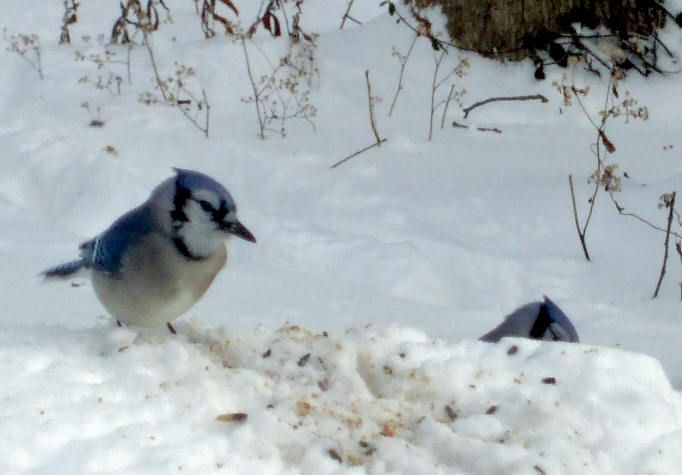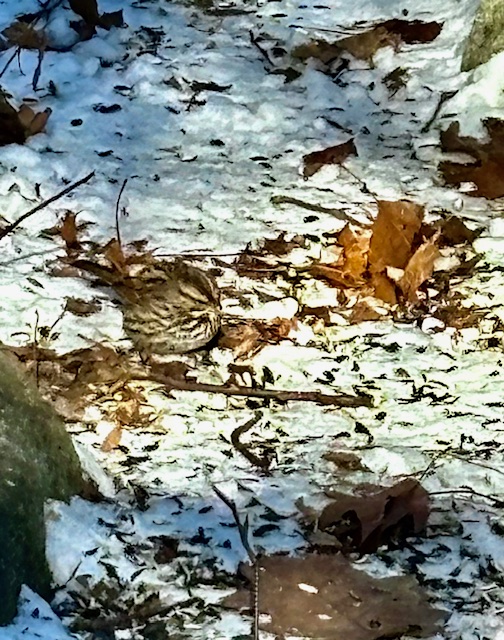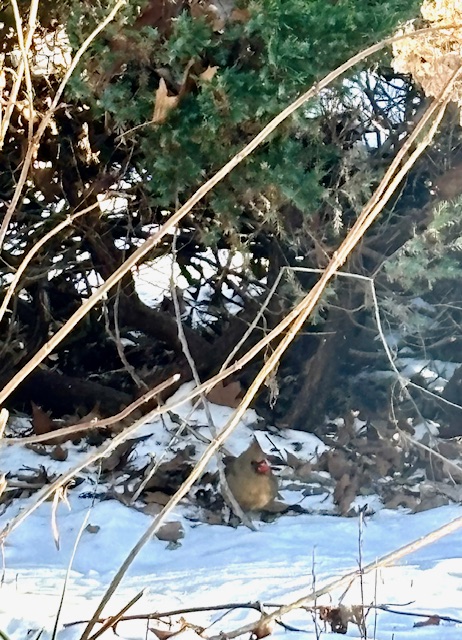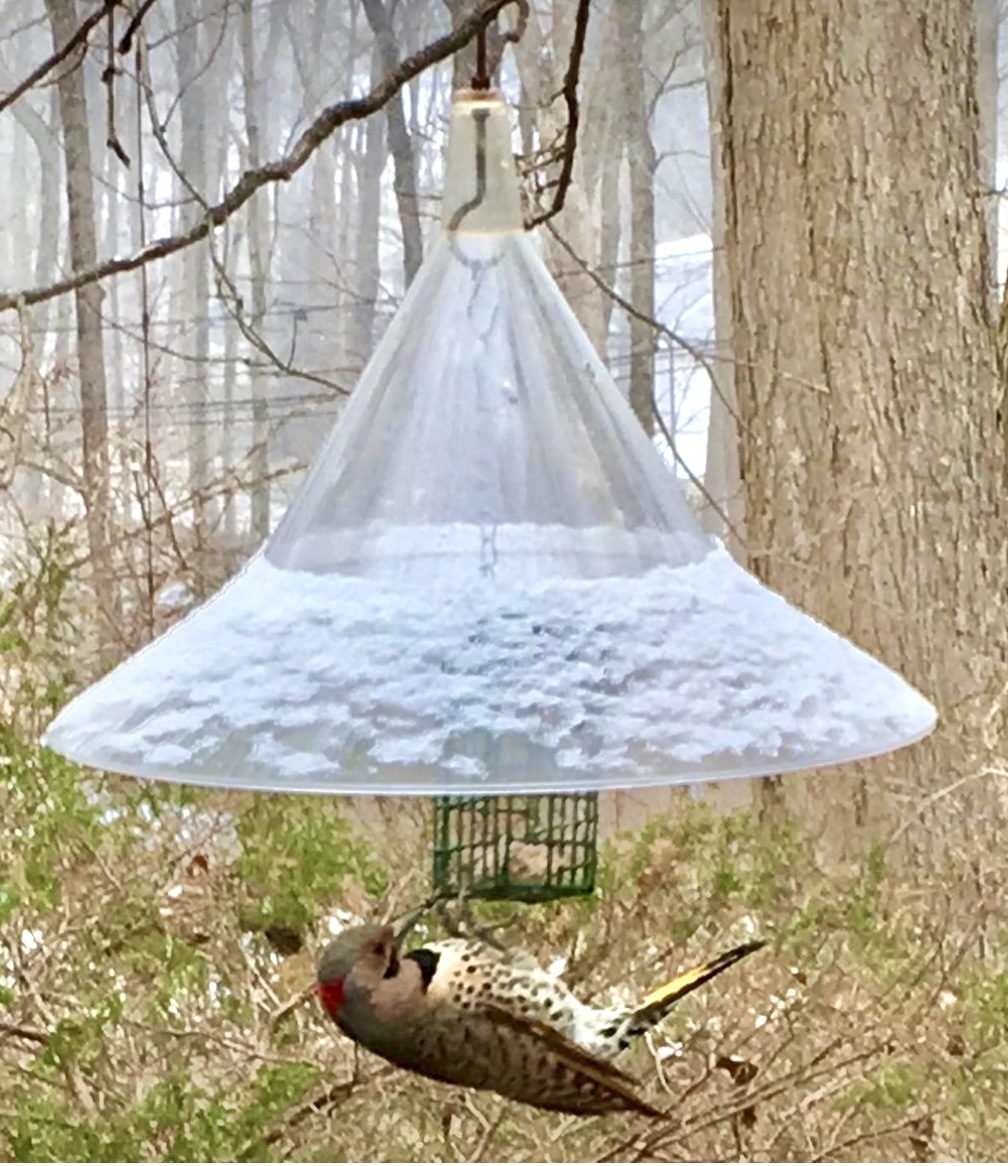
Blue Jays amidst a scattering of bird seed
Birds spend the majority of their waking hours looking for food. Flying requires a lot of energy, which depends on a constant supply of sustenance. When the temperature drops and the leaves fall, many birds head south to warmer climates where food is more abundant. Our ‘home birds,’ the ones who live with us all year round, have adapted to tough it out in the winter. Here is a look at some of those who stay.
The songbirds who fly south for winter are primarily insectivores, while those who stay are omnivores. In addition to consuming all kinds of bugs, the omnivores eat seeds, nuts, fruits, and berries. This versatile diet enables them to survive when insects are inactive and scarce.
Most winter songbirds feed on the ground or in the low understory. Common ground feeders include: white-throated, song and house sparrows; cardinals; mourning doves, blue jays, Carolina wrens and slate-colored juncos. Many hang out in flocks all winter and disperse when mating season arrives in spring. Note: juncos, sometimes called ‘snow birds,’ are not year rounders in Connecticut. They spend winter here and breed in the far north of Canada.


A song sparrow and female cardinal blend into the winter landscape

A yellow-shafted flicker makes an appearance during a thaw
Chickadees, titmice, goldfinches, and house finches occasionally feed on the ground but are more often seen clinging to stalky plants and understory bushes while eating seeds. Nuthatches and brown creepers climb up and down tree trunks, searching the bark for dormant insect larvae.
In addition to songbirds, several species of woodpeckers, hawks, and owls reside in Connecticut all year. Downy, hairy, and red-bellied woodpeckers are most commonly seen and heard in the woods. They forage for insects and larvae tucked underneath the bark of live and dead trees. They also eat seeds, nuts, and suet in bird feeders.

Red-tailed Hawk
Red-tailed, Cooper’s, and sharp-shinned hawks perch in the canopy, watching for any movement of prey below. The former look out for mice, squirrels and rabbits, while the latter catch birds on the wing. Great horned and barred owls mate during winter and can often be heard calling at dawn and dusk.
While our home birds may seem like constant companions, even their populations may fluctuate with changes in weather conditions. While we may see blue jays here all year, the ones we see in the winter may not be the same ones who reside here in summer. Some birds migrate short distances, shifting southward by a hundred miles to find more favorable conditions. Some waterfowl and wading birds, such as herons and egrets, may go to the nearby coast when ponds freeze and return intermittently during thaws.
Once considered the harbingers of spring, Robins are becoming winter residents in southern Connecticut as our climate warms. They travel in flocks in winter. When the ground is not snow-covered, they root for insects hibernating in the leaf mulch. They also love fruits and berries. A large flock can quickly devour all the berries on a single holly bush.

A black-capped chickadee looking for black oil sunflower seeds
Birds in the winter woods are often heard but not seen. Their colors are more muted than in breeding season and blend into the landscape. Bird feeders provide a good opportunity to observe many of our home birds up close. If you don’t have a bird feeder, a wonderful spot to see our winter birds in action is at Bristow Bird and Wildlife Preserve. Several feeders are positioned throughout the sanctuary, and a bird blind overlooks the wetlands.
If you love watching birds, consider participating in the annual Great Backyard Bird Count coming up Feb 16-19. Over a four-day period scientists and volunteers around the world will track and record the birds they see in backyards, communities, parks, open spaces and in the wild. The data collected helps ornithologists assess the strength of bird populations, keep tabs on migration patterns and how habitat degradation and changing climate may be affecting these populations. Volunteers may watch birds for as little as 15 minutes per day and record their findings online. For more information on how to participate go to: https:www.birdcount.org
Recent Comments